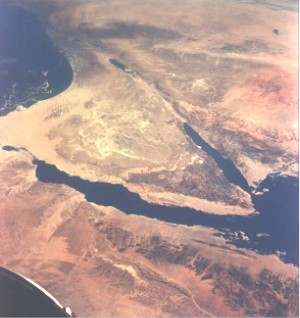NASA photo from space
Sinai Peninsula in center
Dead Sea and Jordan River valley above
The Great Rift Valley is an enormous geographical feature caused by the separation of the African and Arabian tectonic plates around 35 million years ago. It was named by the explorer John Walter Gregory.
The feature runs north to south for over 5,000 km, from northern Syria to Mozambique. The valley varies in width from 30-100 km and in depth from a few hundred to several thousand metres.
The northernmost part of the Rift forms the valley of the Jordan River, which flows southward through the Sea of Galilee to the Dead Sea. From the Dead Sea southwards, the Rift is occupied by the Wadi Arabah and then the Gulf of Aqaba and the Red Sea.
The southern end of the Red Sea marks a fork in the rift. The Gulf of Aden is an eastward continuation of the rift; before the rift opened, the Arabian Peninsula was attached to the Horn of Africa. The rift also continues southwest as the Great Rift Valley, which split the older Ethiopian highlands into two halves.
In eastern Africa the valley splits into two, the Eastern Rift and the Western Rift.
The Western Rift, also called the Albertine Rift, is edged by some of the highest mountains in Africa, including the Virunga Mountains, Mitumba Mountains, and Ruwenzori Range, and contains the Rift Valley lakes, which include some of the deepest lakes in the world (up to 1,470 meters deep at Lake Tanganyika). Lake Victoria, the second largest lake in the world, is considered part of the Rift Valley system although it actually lies between the two branches.
In Kenya the valley is deepest to the north of Nairobi. As the valley has no outlet to the sea, its lakes tend to be shallow and have a high mineral content as the evaporation of water leaves the salts behind. For example, Lake Magadi is almost solid soda (sodium carbonate), and Lake Elmenteita, Lake Baringo, Lake Bogoria, and Lake Nakuru are all strongly alkaline, while Lake Naivasha needs to be supplied by freshwater springs to support its biological variety.
The formation of the Rift Valley is currently ongoing. In a few million years, eastern Africa will probably split off to form a new landmass. The original activity that caused the Rift weakened the Earth's crust. The area is therefore volcanically and seismically active and has produced the volcanic mountains Mount Kilimanjaro, Mount Kenya, Mount Karisimbi, Mount Nyiragongo, Mount Meru and Mount Elgon as well as the Crater Highlands in Tanzania. The Ol Doiyo Lengai volcano remains active, and is currently the only neocarbonate volcano in the world.
The Rift Valley has been a rich source of anthropological discovery, especially in Olduvai Gorge. Because the rapidly eroding highlands have filled the valley with sediments, a favourable environment for the preservation of remains has been created. The bones of several hominid ancestors of modern humans have been found there, including those of "Lucy", a nearly complete australopithecine skeleton, which was discovered by anthropologist Donald Johanson. Richard and Maeve Leakey have also done significant work in this region.
